On The Reportage/Vivid Sydney Censorship Fiasco, And Why It Matters
Censored photojournalists Andrew Quilty, Conor Ashleigh and David Maurice Smith spoke to us about Destination NSW's decision to edit the outdoor projections planned for Reportage.
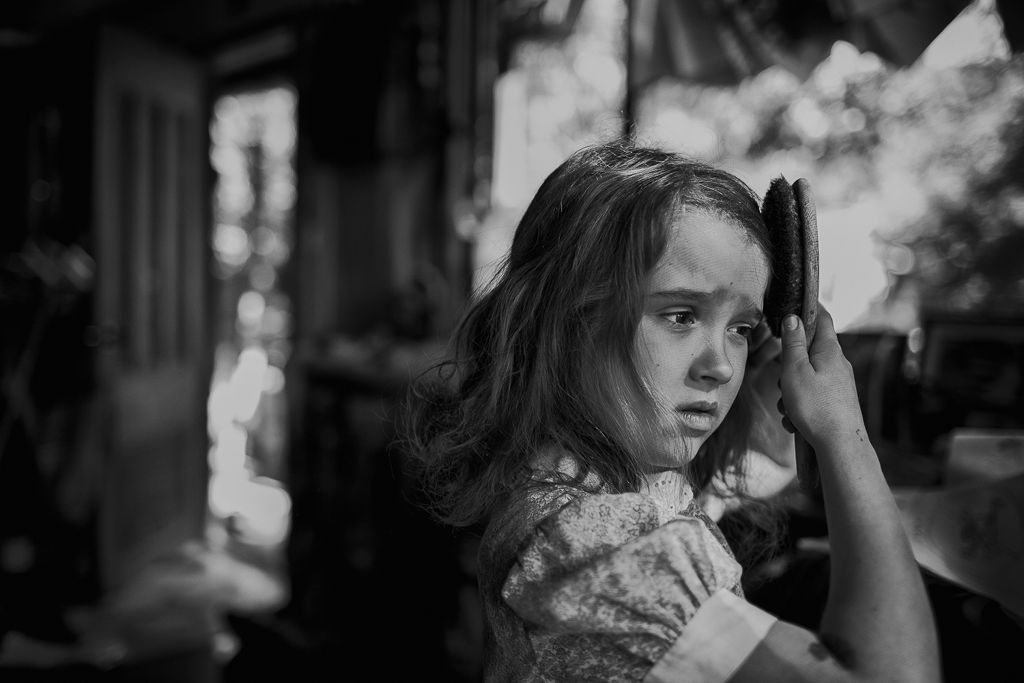
Had the chance to check out Vivid Sydney yet? Maybe you noticed the reduced number of stunning photos being projected during the Vivid Light Walk in Barney and Bligh Reserve? So did the photographers.
Over the weekend, it came out that a number of internationally renowned photographers and photo journalists had their work pulled from the two outdoor projection installations. The work was to be exhibited as part of Reportage, an annual festival that celebrates the best in documentary photography; for the first time, this year’s Reportage is a co-production under the banner of Vivid’s Festival of Light.
The decision to pull the images occurred late last week after a non-negotiable direction from Vivid’s owner and manager, Destination NSW. On Wednesday, Destination NSW’s chief executive officer Sandra Chipchase wandered on down to have a gander at the works that had been prepared by festival director and curator Stephen Dupont and his colleague Ed Giles. Chipchase – the former head of Melbourne Convention and Visitors Bureau — instructed them that further editing was required.
How Was Destination NSW Able To Do This?
An emailed response from Tanya Bowes, the general manager communications for the company, explained: “Destination NSW has a contract with the Reportage organisers, signed by Stephen Dupont, that states that DNSW has editorial approval rights to review and veto any images intended for display in outdoor spaces where Reportage content is being shown.”
Conor Ashleigh is one of the Australian photographers whose work has been pulled: “Why would an agreement for the right to veto work be struck with Reportage?” He is understandably frustrated about the process, particularly because his censored works, pictured below, are seemingly quite innocuous.

With no electricity, just the natural light available through the windows, Mali sits in front of the mirror and sings to herself. © Conor Ashleigh 2013
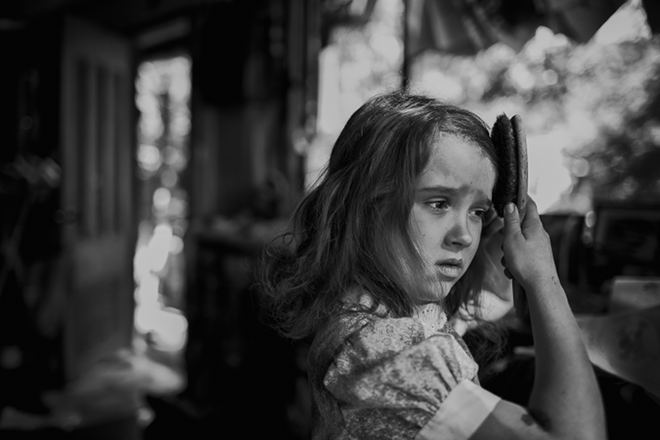
Mali brushes her hair in the morning before leaving home for Chrysalis Steiner School, which is conveniently located on the same land as the community where the family lives. © Conor Ashleigh 2013
In Absentia:
Out of the 39 photographers exhibiting their work through the outdoor projections, fifteen had their work censored: Yuri Kozyrev, Andrew Quilty, David Burnett, Raphaela Rossella, Jack Picone, Francesco Zizola, David Maurice Smith, Ed Giles, Michael Coyne, Conor Ashleigh, Tim Page, Antonio Zambardino, Alex Webb, Paula Bronstein, James Nachtwey. The world’s best were told that their images were too distressing to be shown – something of a smack in the face for professionals from pre-eminent agencies such as Magnum, NOOR and Contact Press Images, most of whom have just arrived in the country to take part in Reportage.
The full range of censored images is available online. The most arresting aspect about the collection is their variety: a photo of gun-loving senior citizens in West Virginia precedes one of Angolan ruins; soldiers embrace anti-Shah protestors in 1979 Tehran, before an anonymous woman’s pregnant belly appears in the gallery. Scrolling through the images, few of them can reasonably be deemed too disturbing for the public. Sure, there is James Nachtwey’s image that many media outlets have shown in the last few days, depicting a victim of the Rwandan genocide, with lateral facial scarring. There is also one image of a used syringe on the ground, two of distraught crowds in Tehran’s Esfand Square, and a rather chilling shot of empty stretchers at the abandoned Abu Slim hospital in Tripoli.
But many of the shots are of people, in familiar activities and terrain. Images from Australian photographers exemplify this: Andrew Quilty’s ravaged Australian landscapes are natural companions to Ashleigh’s photos of family life in the bush. “My images are about a struggling family, who are making do in the country,” Ashleigh says. “It’s absolutely absurd that they’ve been withdrawn. I can’t figure out why this would happen. The only thing I can think of is that they [the family] don’t fit the copy-and-paste idea of a nuclear family – that the images are in some way too ugly, and that that’s going to be distressing [to tourists]. I was talking to the family about it yesterday, and none of us can figure out why this happened.”
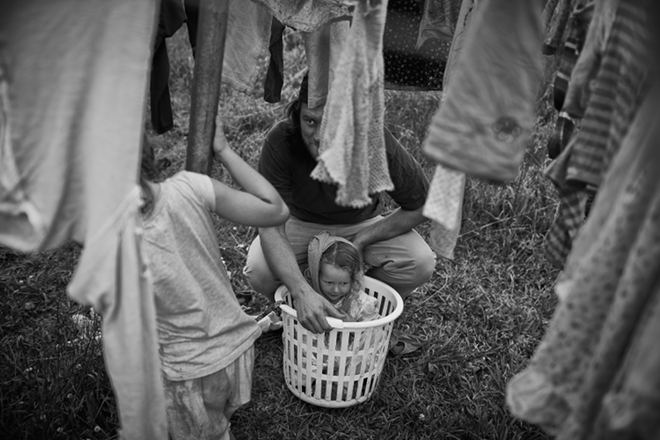
Kai brings in the washing with the help of this two daughters Mali and Lily (inside the washing basket). © Conor Ashleigh 2013
Attack Of The Nanny State?
Andrew Quilty is an Australian photo journalist who’s been the steady hand at the centre of some intense assignments: his black and white shots from The Cronulla Riots in 2005 were featured in TIME Magazine, drawing international attention to the shocking event. So when Quilty expresses enraged disbelief, it is worth paying attention. “I’m dumbfounded at what has gone on, to be honest,” he says. “I hate using clichés like nanny state, but that’s what this feels like. Are we really going to shepherd our audience about? [Because] that is what is happening here.”
Photographers have expressed dismay not only at being censored at Reportage, a festival that has taken care to cultivate intimate relationships with internationally notable photographers over time, but at the way in which it was done.
David Maurice Smith is a Canadian-born photographer, represented in Europe by the prestigious L’agence Vu, and in North America by Redux. Along with Quilty, he is also part of the venerated Australian photography collective Oculi – and he’s scratching his head at what has transpired. “I think this a case of a missed opportunity for Vivid, for Destination NSW and for Sydney to be progressive,” he says. “They invited Reportage to be a part of what they were doing, and invited documentary photographers from around the world. I cannot understand why they would do that, if they were going to go down this path. The process was unacceptable, and the stuff that they were pulling — well, it was ridiculous.”
“My work was one of the first to get pulled,” he says, of his stark images of rusted-on rural life, pictured below. “And that was a long time before last week. Reportage had to go through multiple processes of culling: they were told certain things were unacceptable, and then later told other things were unacceptable, so they had to change that again.”
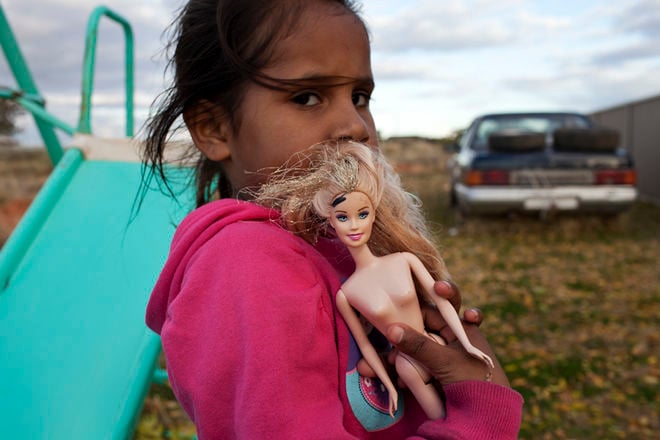
Rhianna Harris (age 5) and her doll in Wilcannia, New South Wales, Australia. A large socioeconomic gap means that Rhianna will be faced with social barriers not faced by her non-Aboriginal counterparts. © David Maurice Smith / Oculi 2012
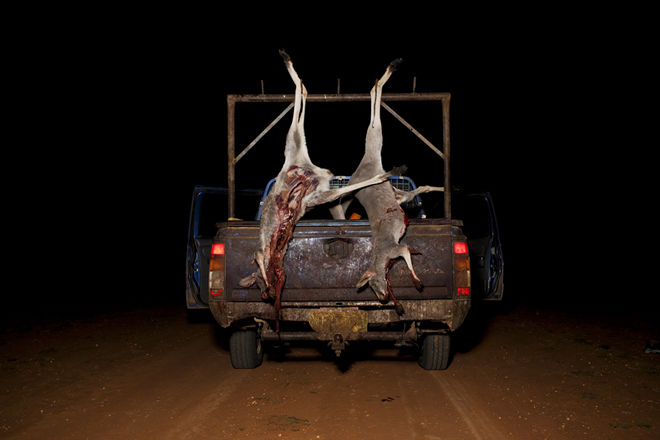
Dead kangaroos, hunted for their meat hang off the back of a truck in Wilcannia, New South Wales, Australia. Wild “bush” meat is an important supplement to the diet of many in Wilcannia for traditional reasons and because the high prices of store bought meat means it is unavailable to many in the community. © David Maurice Smith / Oculi 2012

A man prepares to smoke Marijuana from a homemade water bong in Wilcannia, New South Wales, Australia. © David Maurice Smith/Oculi.
The culling had seemingly reached an end, until the saga picked up again last Wednesday. “I was invited to be part of this particular projection project months ago,” Quilty says. “After I signed on, Vivid approached Reportage asking to piggyback the festival. I know there were a few early issues, and then last Wednesday the CEO of Destination NSW came in and cast her eye over the screens, and took the heavy handed approach that some bodies of work had to be culled entirely.”
According to Smith, the verdict was that more than half of it couldn’t be shown. “It doesn’t take a highly informed person to realise that this is a case of bureaucracy covering its own butt.”
Commerce Verses Art:
In an emailed response, Destination NSW spokesperson Tanya Bowes said that “some images were removed on the basis that they might offend or distress families, children and the general public attending Vivid and/or were not in keeping with the values of the event.”
Andrew Quilty is familiar with the competing commercial demands that photographers face. A Walkley Award winner, he’s spent many years as the staff photographer for the Australian Financial Review, and has been published in The New York Times, Le Monde and Vanity Fair. “There will always be a struggle between advertising and editorial,” he says, “and they obviously don’t want dead babies near the shiny new cars they are trying to sell. But the thing that shits me is that this [censorship] has come down to one person, who has come in and gone about this in completely the wrong way. And they’ve put Reportage in a really shit position.”
The photographers believe the language used by Destination NSW in the media coverage that followed the censorship was deliberately misleading. “[Sandra Chipchase was quoted as saying that] the work that was culled was all dead babies, which is just not true,” says David Maurice Smith. “That totally belittled the amount of sensitivity that we bring to our work. We are documentary photographers, and we are not out to shock. I think it was a convenient soundbite to mention dead babies, when in reality the work that was culled is completely different to that. There is some beautiful and very moving imagery that should have been seen. Images like Conor’s are beautiful, and you can’t get around that.”
Big Names Bugger Off:
Italian photographer Francesco Zizola was outraged at the censorship. The founder of Europe’s Noor and 10B photography agencies had eight of his 40 images deemed too distressing for public view. Zizola felt that the culling of his series – which covers the last decade of life in war-torn countries like Angola, Sierra Leone and Iraq – would be compromised, so withdrew his entire retrospective from the exhibition.
South African Jodi Bieber also withdrew her work from the outdoor projections, although her work is still appearing at an outdoor installation exhibition in the Darling Quarter celebrating female documentary photographers: 4 Stories: Four Women, Four Visions, Four Stories, Four Corners also features the work of Tamara Dean, Claire Martin and Raphaela Rosella.
Reportage circulated a press release on Monday evening, stating that the censored images will still be displayed at indoor venues around the city. “We encourage people to seek the work out and inform themselves,” Stephen Dupont said. The non-culled images will still be projected outdoors as part of Vivid Light Walk, with the exception of the remainder of Francesco Zizola’s retrospective.
Reportage’s association with Vivid has allowed them to bring many more big names to Australia for this year’s event, but the full cost to Australia’s cultural identity and international reputation is yet to be seen.
–
Benjamin Cooper is a journalist for Fairfax. He has had his work published in TheVine, Cyclic Defrost, The BRAG, Beat Magazine and Time Out Australia.
With thanks to Conor Ashleigh, David Maurice Smith and Francesco Zizola for permission to use their photographs.
JUNE 3 CORRECTION: This piece initially stated that Jodi Bieber was to withdraw from the festival altogether.



